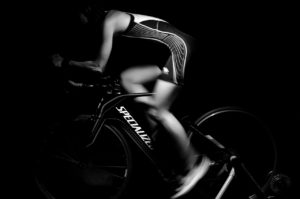
Nope! You do not need a smart trainer to get the most out of your training and racing.
There. Shortest article we’ve written yet!
Oh, you wanted a more in-depth answer as to whether or not you need a smart trainer? Well, no one has ever accused either of us of being short winded, so continue reading and we will not only tell you why you do not need a smart trainer, but also why there are better investments you can make if you’re looking to improve both your training and racing.
Available Technology
I believe there is a hierarchy to the technology that helps you get the most out of your cycling training and propose it looks something like the following:
- Heart rate
- “Dumb” Trainer with virtual power
- Smart trainer without a separate power meter
- “Dumb” Trainer with a power meter
- Smart trainer with a power meter
Let’s break down each of these options and how they might help you train.
Heart Rate
One of the oldest ways to measure how hard you are working. Unfortunately, heart rate is a lagging indicator whereas power is an instantaneous measure of what you are doing. Heart rate can also be impacted by outside factors such as the temperature, humidity, how well you slept the night before, etc. It’s a great metric to track and definitely something to keep an eye on come race day, but you will generally get more out of a power based workout.
“Dumb” Trainer with Virtual Power
The cheapest way to begin training with power. We have had great success with the Kinetic line of products and I have been using the Rock and Roll trainer for several years without a single problem (you can find the older dumb versions for sale used for $200 – $300) . Products such as Trainer Road and Zwift have known power curves for the various trainers and do a decent job of estimating your power. It will not be as accurate as an actual power meter, but it can be consistent if you set everything up properly (aka, repeatably) and this allows you to properly set your training zones.
Smart Trainer without a Power Meter
Now you are getting into the world of actual power. A smart trainer is going to be more accurate than virtual power and won’t rely on your ability to repeatably setup your bike (tire pressure, flywheel pressure, etc.). Smart trainers also add Erg mode, which essentially sets the resistance for you regardless of cadence or gearing. This allows for some fun rides when using services like Zwift as it will automatically adjust the resistance based on the virtual hills you are riding. Another advantage is that you will generally have a smoother power output during a workout compared to a stand alone power meter.
One drawback of smart trainers is the added complexity they bring to training. We have had a few athletes use them over the years and it seems like we spend more time troubleshooting the smart trainers than we do helping our athletes train. This is particularly true with some of the less expensive smart trainers. Some of the higher end units like the Tacx Neo Smart and the Wahoo Kickr have had fewer issues (in our experience). Please keep in mind this is anecdotal evidence at best, but it has been our experience thus far.
Power Meter with a Dumb Trainer
Now we are getting into the fun stuff. Coach Scott will be the first to tell you that I LOVE technology and the power meter is one of my favorites. Why do I put a power meter with a dumb trainer over a stand alone smart trainer? Simple, it’s the best of all worlds! It allows you to use power both indoors (for the most effective and efficient workouts) but also also allows you to take your power outside for training AND racing.
Power outdoors won’t be as important if you are focusing on short events such as a sprint triathlon. These races generally require you to go as hard as you can and pacing isn’t quite as important. If you’re thinking of going longer, such as a 70.3 or even a full Ironman, a power meter becomes invaluable in helping to ensure you not only have a great ride, but also a great run, and at the end of the day a triathlon is a multi-sport race and not a bike race. Visit any Ironman race and you’ll hear countless guys (it seems like its always us guys) walking the run course talking about their awesome bike split! A power meter and proper pacing can help you avoid this.
Another advantage of this setup is that you can purchase a power meter and a solid dumb trainer for less than the higher end smart trainers.
Smart Trainer with a Power Meter
Okay, if you’ve made it this far, this should probably make sense. A stand alone power meter coupled with a smart trainer is truly the best of both worlds. It allows you the option of erg mode and a more interactive/realistic experience indoors using something like Zwift, but also allows you to take your power outdoors for training and racing. This improved indoor experience can help you get through the long and often mind-numbing winters, assuming you’re in a cold weather climate like myself.
Most power meters will register a different number than a smart trainer simply because of where they are measuring power. No process is 100% efficient so the measured watts will vary based on where power is being measured (wheel, pedals, spider, crank, etc). Sites like Zwift and Trainer Road will let you use your power meter to control the smart trainer so that you are using the same numbers both indoors and outdoors.
This is truly the way to go if money is no object, but it will be costly. The good smart trainers cost north of $1,000 and good power meters can be had for somewhere in the $500 – $1,000 range.
Conclusion
If you’ve been around triathlon or cycling for any length of time the conclusions I’ve drawn in this post shouldn’t come as much of a surprise. We are strong proponents of training with power and prefer that all of our athletes do so, although it’s not mandatory. We have, however, noticed the biggest improvement with athletes who have made the plunge and entered the world of power.
